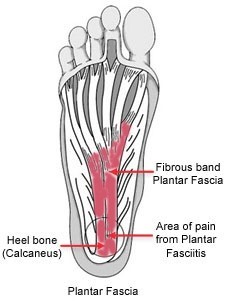PLANTAR FASCIITIS
The most common cause of heel pain is plantar fasciitis. From the heel to the toes of the foot there is a longitudinal arch, the plantar fascia. It is a thick cord of fibrous tissue that is attached at the bottom of the heel and fans out to the ball of the foot, attaching at the base of the toes. The plantar fascia acts something like a shock absorber. Whenever there is weight put through the foot the plantar fascia is under tension and stretched.
The plantar fascia is most commonly sore where it attaches into the heel.
There are also many more causes of heel pain, including thinning of the fatty padding under the foot, bursitis, fracture and nerve entrapment.

Common symptoms of heel pain are:
- Pain in the morning when you first get out of bed and place weight on the foot
- Sharp searing pain, or a tearing feeling in the bottom of the heel and arch.
- Pain and stiffness when you start to walk after having been seated for a while.
- Increasing pain in your heels or arches towards the end of each day.
- Tired or throbbing feet at the end of the day when not weight bearing.
- Pain that radiates into the arch of the foot.
It is important that your plantar fasciitis is treated, as often people develop a number of painful injuries by trying to walk differently to avoid the pain. You can get some great results even if you feel like you have tried everything.
The great thing about your heel pain is that it is very treatable without the need for painful surgery or needles. Treatments should focus on treating the true cause of your foot pain, that is the repeat straining which happens with every step you take.
Prescription orthotics aim to comfortably rest the plantar fascia whilst you stand and walk. We are also able to provide instant pain relief and speed up your healing with Dolorclast Therapy so that you can get back to your life more quickly.
At your appointment your podiatrist will assess you thoroughly by asking detailed questions, locating the painful area, evaluating your foot and lower limb posture and gait and assessing the joints in your foot and lower limb. They will send you for x-rays and ultrasound if required, although generally your diagnosis will be reached at your first appointment, so the treatment process can be started straight away.